

 |
Search the Site with

|
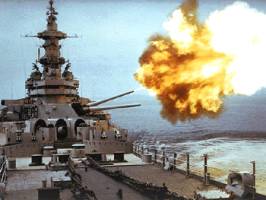 | 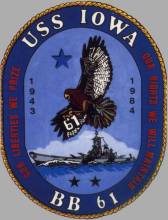 | 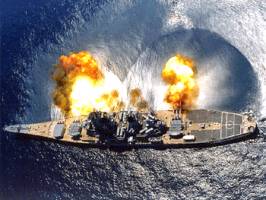 |
USS IOWA was the first ship in the United States’ last class of battleships and the third ship in the Navy to bear the name of the state. During her long life she was commissioned for 227 months. Today, the IOWA is preserved as a museum near Los Angeles at San Pedro, Calif.
| General Characteristics: | Keel laid: June 27, 1940 |
| Launched: August 27, 1942 | |
| Commissioned: February 22, 1943 | |
| Decommissioned: March 24, 1949 | |
| Second commissioning: August 25, 1951 | |
| Second decommissioning: February 24, 1958 | |
| Third commissioning: April 28, 1984 | |
| Third decommissioning: October 26, 1990 | |
| Builder: New York Naval Shipyard, Brooklyn, NY | |
| Propulsion system: eight boilers, four geared turbines | |
| Propellers: four | |
| Length: 889 feet (271 meters) | |
| Beam: 108 feet (32.9 meters) | |
| Draft: 35,7 feet (10.9 meters) | |
| Displacement: Light: approx. 46,000 tons | |
| Full: approx. 57,000 tons | |
| Speed: 33 knots | |
| Aircraft: no hangar, but parking area for four | |
| Crew 1984 - 1990: 65 officers and 1,501 enlisted | |
| WWII Crew: 134 officers and 2,400 enlisted | |
| Last armament: eight armored box launchers for |
Crew List:
This section contains the names of sailors who served aboard USS IOWA. It is no official listing but contains the names of sailors who submitted their information.
USS IOWA Cruise Books:
Accidents aboard USS IOWA:
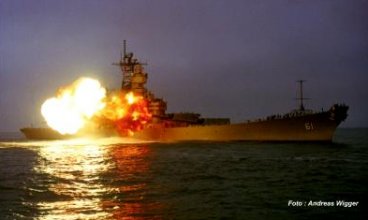 | 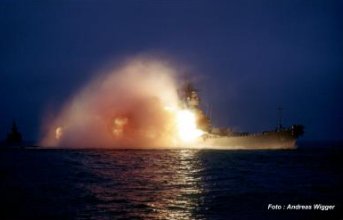 |
| The two photos above were taken by Andreas Wigger and show the IOWA during a gun fire demonstration off the island of Bornholm in the Baltic Sea in October 1985. | |
History of USS IOWA:
The USS Iowa was laid down at New York Navy Yard, 27 June 1940; launched 27 August 1942; sponsored by Mrs. Henry A. Wallace, wife of Vice President Wallace, and commissioned 22 February 1943, Capt. John L. McCrea in command.
On 24 February, Iowa put to sea for shakedown In Chesapeake Bay and along the Atlantic coast. She got underway, 27 August for Newfoundland to neutralize the threat of German battleship Tirpitz which was reportedly operating In Norwegian waters.
In the fall, Iowa carried President Franklin D. Roosevelt to Casablanca, French Morocco, on the first leg of his journey to the Teheran Conference in November. After the conference she returned the President to the United States. As flagship of Battleship Division 7, Iowa departed the United States 2 January 1944 for the Pacific Theatre and her combat debut in the campaign for the Marshalls. From 29 January to 3 February, she supported carrier air strikes made by Rear Admiral Frederick C. Sherman's task group against Kwajalein and Eniwetok Atolls in the Marshall Islands.
Her next assignment was to support air strikes against the Japanese Naval base at Truk, Caroline Islands. Iowa, in company with other ships was detached from the support group 16 February 1944 to conduct an anti-shipping sweep around Truk to destroy enemy naval vessels escaping to the north. On 21 February, she was underway with Fast Carrier Task Force 58 while it conducted the first strikes against Saipan, Tinian, Rota, and Guam in the Marianas.
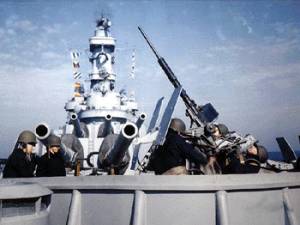 On 18 March, Iowa, flying the flag of Vice Admiral Willis A. Lee, Commander Battleships, Pacific, joined in the bombardment of Mili Atoll in the Marshall Islands. Although struck by two Japanese 4.7" projectiles during the action, Iowa suffered negligible damage. She then rejoined Task Force 58, 30 March, and supported air strikes which continued for several days against the Palau Islands and Woleai of the Carolines.
On 18 March, Iowa, flying the flag of Vice Admiral Willis A. Lee, Commander Battleships, Pacific, joined in the bombardment of Mili Atoll in the Marshall Islands. Although struck by two Japanese 4.7" projectiles during the action, Iowa suffered negligible damage. She then rejoined Task Force 58, 30 March, and supported air strikes which continued for several days against the Palau Islands and Woleai of the Carolines.
From 22 to 28 April 1944, Iowa supported air raids on Hollandia, Aitape, and Wake Islands to support Army forces on Aitape, Tanahmerah Bay, and Humboldt Bay in New Guinea. She then joined the Task Force's second strike on Truk, 29-30 April, and bombarded Japanese facilities on Ponape in the Carolines, 1 May.
In the opening phases of the Marianas campaign, Iowa protected the flattops during air strikes on the islands of Saipan, Tinian, Guam, Rota, and Pagan, 12 June. Iowa was then detached to bombard enemy installations on Saipan and Tinian, 13-14 June. On 19 June, in an engagement known as the Battle of the Philippine Sea, Iowa, as part of the battle line of Fast Carrier Task Force 58, helped repel four massive air raids launched by the Japanese Middle Fleet. This resulted in the almost complete destruction of Japanese carrier-based aircraft. Iowa then joined in the pursuit of the fleeing enemy fleet, shooting down one torpedo plane and assisting in splashing another.
Throughout July, Iowa remained off the Marianas supporting air strikes on the Palaus and landings on Guam. After a month's rest, Iowa sortied from Eniwetok as part of the 3d Fleet, and helped support the landings on Peleliu, 17 September. She then protected the carriers during air strikes against the Central Philippines to neutralize enemy air power for the long awaited invasion of the Philippines. On 10 October, Iowa arrived off Okinawa for a series of air strikes on the Ryukyus and Formosa. She then supported air strikes against Luzon, 18 October and continued this vital duty during General MacArthur's landing on Leyte 20 October.
In a last ditch attempt to halt the United States campaign to recapture the Philippines, the Japanese Navy struck back with a three-pronged attack aimed at the destruction of American amphibious forces In Leyte Gulf. Iowa accompanied TF-38 during attacks against the Japanese Central Force as it steamed through the Sibuyan Sea toward San Bernardino Strait. The reported results of these attacks and the apparent retreat of the Japanese Central Force led Admiral Halsey to believe that this force had been ruined as an effective fighting group. Iowa, with Task Force 38 steamed after the Japanese Northern Force off Cape Engano, Luzon.
On 25 October 1944, when the ships of the Northern Force were almost within range of Iowa's guns, word arrived that the Japanese Central Force was attacking a group of American escort carriers off Samar. This threat to the American beachheads forced her to reverse course and steam to support the vulnerable "baby carriers." However, the valiant fight put up by the escort carriers and their screen had already caused the Japanese to retire and Iowa was denied a surface action. Following the Battle for Leyte Gulf, Iowa remained in the waters off the Philippines screening carriers during strikes against Luzon and Formosa. She sailed for the West Coast late in December 1944.
Iowa arrived San Francisco, 15 January 1945, for overhaul. She sailed 19 March 1945 for Okinawa, arriving 15 April 1945. Commencing 24 April 1945, Iowa supported carrier operations which assured American troops vital air superiority during their struggle for that bitterly contested Island. She then supported air strikes off southern Kyushu from 25 May to 13 June 1945. Iowa participated in strikes on the Japanese homeland 14-15 July and bombarded Muroran, Hokkaido, destroying steel mills and other targets. The city of Hitachi on Honshu was given the same treatment on the night of 17-18 July 1945. Iowa continued to support fast carrier strikes until the cessation of hostilities, 13 August 1945.
Iowa entered Tokyo Bay with the occupation forces, 29 August 1945. After serving as Admiral William F. Halsey's flagship for the surrender ceremony, 2 September 1945, Iowa departed Tokyo Bay 20 September 1945 for the United States.
Arriving Seattle, Wash., 15 October 1945, Iowa returned to Japanese waters in January 1946 and became flagship of the 5th Fleet. She continued this role until she sailed for the United States 25 March 1946. From that time on, until September 1948, Iowa operated from West Coast ports, on Naval Reserve and at sea training and drills and maneuvers with the Fleet. Iowa decommissioned 24 March 1949.
After Communist aggression in Korea necessitated an expansion of the active fleet, Iowa recommissioned 25 August 1951, Captain William R. Smedberg III in command. She operated off the West Coast until March 1952, when she sailed for the Far East. On 1 April 1952, Iowa became the flagship of Vice Admiral Robert T. Briscoe, Commander, 7th fleet, and departed Yokosuka, Japan, to support United Nations Forces in Korea. From 8 April to 16 October 1952, Iowa was involved in combat operations off the East Coast of Korea. Her primary mission was to aid ground troops, by bombarding enemy targets at Songjin, Hunguam, and Kojo, North Korea. During this time, Admiral Briscoe was relieved as Commander, 7th Fleet. Vice Admiral J. J. Clark, the new commander, continued to use Iowa as his flagship until 17 October 1952. Iowa departed Yokosuka, Japan 19 October 1952 for overhaul at Norfolk and training operations in the Caribbean Sea.
Iowa embarked midshipmen for at sea training to Northern Europe, July 1953, and immediately after took part in Operation "Mariner," a major NATO exercise, serving as flagship of Vice Admiral E. T. Woolfidge, commanding the 2d Fleet. Upon completion of this exercise, until the fall of 1954, Iowa operated in the Virginia Capes area. In September 1954, she became the flagship of Rear Admiral R. E. Libby, Commander, Battleship-Cruiser Force, U.S. Atlantic Fleet.
From January to April 1955, Iowa made an extended cruise to the Mediterranean as the first battleship regularly assigned to Commander, 6th Fleet. Iowa departed on a midshipman training cruise 1 June 1955 and upon her return, she entered Norfolk for a four-month overhaul. Following refit, Iowa continued intermittent training cruises and operational exercises, until 4 January 1957 when she departed Norfolk for duty with the 6th Fleet in the Mediterranean. Upon completion of this deployment, Iowa embarked midshipmen for a South American training cruise and joined in the International Naval Review off Hampton Roads, Va., 13 June 1957.
On 3 September 1957, Iowa sailed for Scotland for NATO Operation Strikeback. She returned to Norfolk, 28 September 1957 and departed Hampton Roads for the Philadelphia Naval Shipyard, 22 October 1957. She decommissioned a second time on 24 February 1958.
After two and a half decades in "mothballs", Iowa was modernized under the 1980s defense buildup and recommissioned 28 April 1984. She went to European waters in 1985, 1986 and 1987 through 1988, with the latter cruise continuing into the Indian Ocean and Arabian Sea.
On 19 April 1989, an explosion of undetermined cause ripped through her Number Two sixteen-inch gun turret killing 47 crewmen. Iowa was still able to deploy to Europe and the Mediterranean Sea in mid-year. Turret Two remained unrepaired when she decommissioned in Norfolk, Va., for the last time 26 October 1990. Iowa is presently part of the Reserve Fleet, berthed at the Naval Education and Training Center in Newport, R.I., since 24 Sept. 1998.
Iowa earned nine battle stars for World War II service and two for Korean service.
Deployments of USS IOWA:
USS IOWA’s Commanding Officers:
| Period | Name |
|---|---|
| February 22, 1943 – August 1944 | Captain John L. McCrea, USN |
| August 1944 – November 1944 | Captain Allan R. McCann, USN |
| November 1944 – July 1945 | Captain James L. Holloway Jr., USN |
| July 1945 – November 1945 | Captain Charles Wellborn Jr., USN |
| November 1945 – July 1946 | Captain Frederick I. Entwistle, USN |
| July 1946 – April 1947 | Captain Raymond D. Tarbuck, USN |
| April 1947 – March 1948 | Captain Thomas M. Stokes, USN |
| March 1948 – August 1948 | Captain Edward A. Solomons, USN |
| August 1948 – January 1949 | Captain William F. Jennings, USN |
| January 1949 – March 24, 1949 | Captain Bennett M. Dodson, USN |
| August 25, 1951 – July 1952 | Captain William R. Smedberg III, USN |
| July 1952 – July 1953 | Captain Joshua W. Cooper, USN |
| July 1953 – September 1954 | Captain Wayne R. Loud, USN |
| September 1954 – November 1955 | Captain William C. Bryson, USN |
| November 1955 – December 1956 | Captain John W. Ailes III, USN |
| December 1956 – February 24, 1958 | Captain F. Julian Becton, USN |
| April 28, 1984 – July 1986 | Captain Gerald E. Gneckow, USN |
| July 1986 – May 1988 | Captain Larry Seaquist, USN |
| May 1988 – May 1990 | Captain Fred P. Mossally, USN |
| May 1990 – October 26, 1990 | Captain John P. Moorse, USN |
USS IOWA Image Gallery:
 | 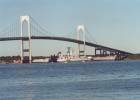 | 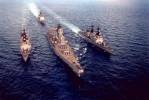 | 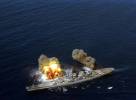 | 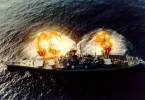 |
 | 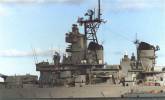 | 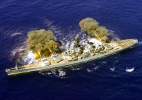 | 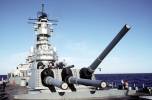 | 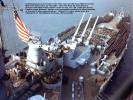 |
 |  | 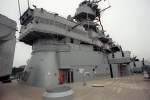 | 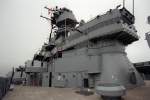 | 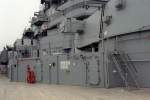 |
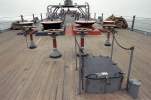 | 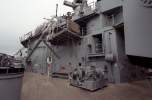 | 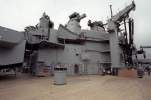 |  | 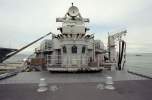 |
The photos below were taken by Carl Groll when USS IOWA visited the German port of Kiel in October 1985, after her participation in BALTOPS '85. The ship in front of the IOWA on the last two pictures is the German destroyer ROMMEL (D 187).
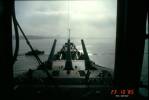 | 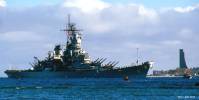 | 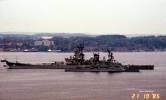 | 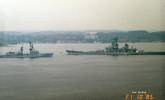 |
The photos below were taken by me and show the IOWA laid-up at Suisun Bay, Calif., on March 27, 2010.
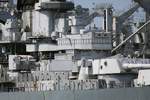 | 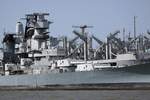 | 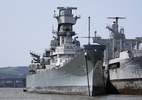 | 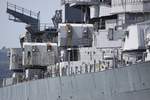 | 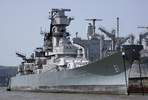 |
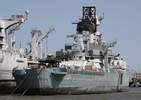 | 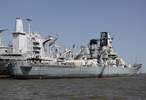 | 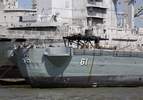 | Click here for more photos. | |
The photos below were taken by me and show the IOWA berthed at Richmond, Calif., on March 17, 2012. The IOWA was towed to Richmond from Suisun Bay in fall 2011 in order to be prepared for her future role as a museum ship in the port of Los Angeles, Calif. During the refurbishment in Richmond, the IOWA was open for public tours on weekends, however, public access was limited to the ship's bow section.
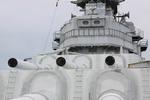 | 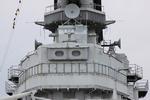 | 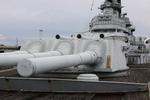 |  |  |
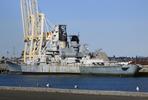 | 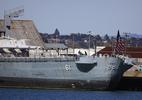 | 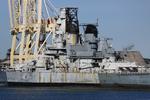 | Click here for more photos. | |
The photos below were taken by Michael Jenning during a visit to the USS IOWA museum in San Pedro, Calif., on December 29, 2014
 |  | 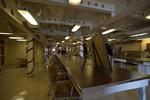 | 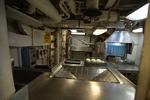 | 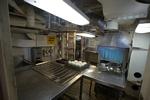 |
 | 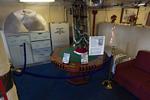 |  | Click here for more photos. | |
 Back to Battleships list.
Back to Battleships list.  Back to ships list.
Back to ships list.  Back to selection page.
Back to selection page.  Back to 1st page.
Back to 1st page.